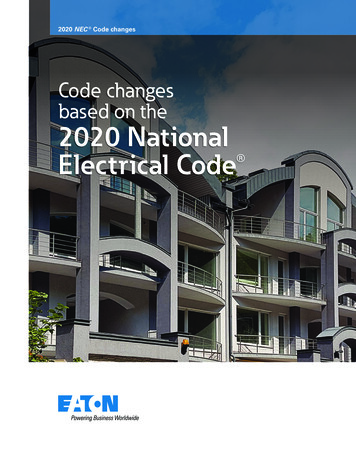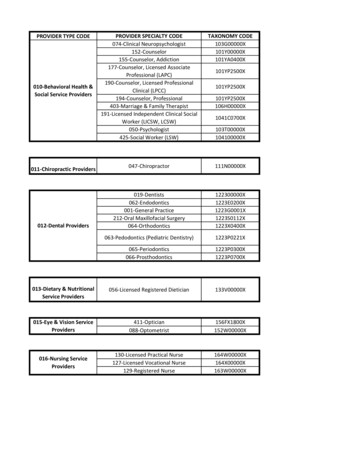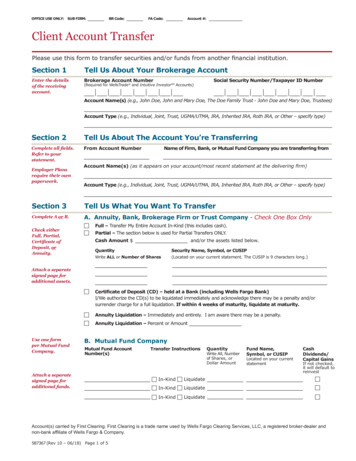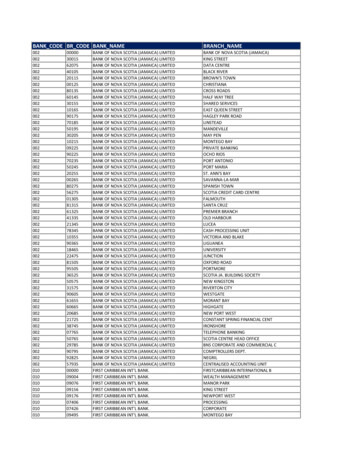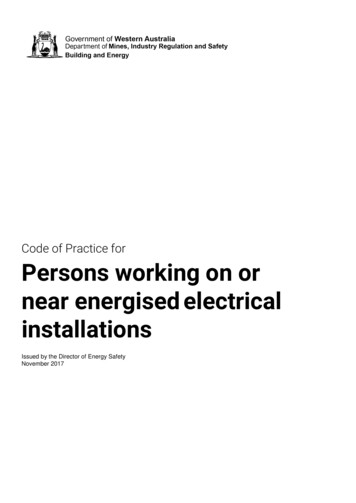
Transcription
Code of Practice forPersons working on ornear energised electricalinstallationsIssued by the Director of Energy SafetyNovember 2017
2PrefaceEnergySafety has developed this Code of Practice for Persons Working on or NearEnergised Electrical Installations (the Code).The Code commences on the day the Electricity (Licensing) Amendment Regulations (No. 2)2017 commences.Compliance with the Code is made mandatory by Regulation 49(1) of the Electricity(Licensing) Regulations 1991.A downloadable copy of the Code is available from EnergySafety’s website atwww.dmirs.wa.gov.au/energysafety.Ken BowronDirector of Energy SafetyNovember 2017Code of Practice for Persons working on or near energised electrical installations
Contents1.Scope of this Code . 42.Definitions . 53.Responsibilities . 54.Work on electrical installations – de-energised work. 64.1 Procedure for de-energising. 64.2 Risks when fault finding and testing on de-energised equipment . 65.Carrying out electrical work on or near energised electrical installations . 75.1 Summary of requirements before electrical work is carried out on or near energisedelectricalinstallations . 75.2 Risk assessment . 75.2.1 Typical risks when carrying out electrical work on or near energised electricalinstallations . 85.2.2 Hazards indirectly caused by electricity—conductive materials . 85.2.3 Arc Flash Hazard . 95.2.4 Risks when fault finding and testing on energised equipment. 95.2.5 Further guidance on the Risk Assessment Process . 95.3 Assessment by the competent person . 105.4 Safe work method statement (SWMS) . 105.5 Tools and equipment . 115.5.1 Training of electrical workers on testing . 115.5.2 Personal protective equipment (PPE) . 115.6 Safety barriers . 125.7 Safety signs . 125.8 Safety observers . 125.9 Completion of work . 135.10 Leaving work unfinished . 135.11 Emergency planning . 14Appendix ASafe Work Method Statement – Template . 15Appendix BDecision Flowchart – Work on or near energised electrical installations . 17Code of Practice for Persons working on or near energised electrical installations
41. Scope of this CodeRegulation 55 of the Electricity (Licensing) Regulations 1991 prohibits electrical work onor near an energised part of an electrical installation except under certain specificsituations prescribed in Sub-regulation 55(2).This Code prescribes additional requirements for those persons who will be authorisingor carrying out electrical work on or near energised electrical installations. It is to beread in conjunction with the Occupational Safety and Health Regulations 1996 (OSHR),in particular Part 3 Division 6.Compliance with the Code may be achieved by following another method utilising soundrisk management practices, if it provides an equivalent or higher standard of electricalsafety than the Code.The Code applies to all electrical work on low-voltage and high-voltage installations. Itdoes not apply to work on extra-low voltage1 electrical equipment.Regulation 55 does not apply to a network operator’s network but does apply toelectrical installations that are not part of the network operator’s network such asgeneral power and lighting in switchyards and associated control buildings.This Code has been made in accordance with Part VI of the Interpretation Act 1984 andhas the power of subsidiary legislation. It is referenced in Regulation 49(1) of theElectricity (Licensing) Regulations 1991.1Voltages that do not exceed 50 volts a.c. or 120 volts ripple-free d.c.Code of Practice for Persons working on or near energised electrical installations
52. DefinitionsThe following terms used in this Code have the same meaning as those terms in theElectricity (Licensing) Regulations 1991:de-energised has the meaning given in Regulation 3;electrical installation has the meaning given in Regulation 3;energised has the meaning given in Regulation 3;electrical work has the meaning given in Regulation 4A;near has the meaning given in Sub-regulation 54A(2);written form includes retrievable electronic records.The term competent person used in this Code has the meaning given in Regulation 1.3of the Occupational Safety and Health Regulations 1996:“competent person, in relation to the doing of anything, means a person who hasacquired through training, qualification or experience, or a combination of thosethings, the knowledge and skills required to do that thing competently.”3. ResponsibilitiesThe following persons are collectively responsible for ensuring that electrical work iscarried out under de-energised conditions in all circumstances except as permitted byRegulation 55:21.A person carrying out electrical work;2.An electrical contractor or in-house electrical installing work licence holder;3.A person who, at a workplace, is2: an employer; the main contractor; a self-employed person; a person having control of the workplace; or a person having control of access to the workplace.See Occupational Safety and Health Regulations 1996 for the definition of the listed persons.Code of Practice for Persons working on or near energised electrical installations
64. Work on electrical installations – de-energised work4.1 Procedure for de-energisingThe most effective safety control measure is to de-energise the relevant part of theelectrical installation and to ensure the work is not carried out near any part of theinstallation that remains energised.Before any electrical work is undertaken, the responsible person must ensure theelectrical installation or the relevant part of the electrical installation to be worked on:a.is tested by a competent person to ascertain whether or not it is energised;andb.if it is found to be energised, is de-energised by a competent person.To effectively de-energise the electrical equipment or circuit to be worked on, thefollowing procedural steps should be taken in the order shown:1) Identify the circuit to be worked on and verify it is the correct circuit by testing i.e.do not rely on labels or other means.2) Disconnect all supplies of electricity to the installation, or that part of it to beworked on, by opening the necessary switches and/or removing fuses and links.There might be multiple network connections, standby generators, solar panels,batteries, back-up supplies or uninterruptable power supplies from other parts ofthe installation.3) If work will be carried out near other energised parts of the installation,disconnect the electricity supply to these parts of the installation as well orprovide barriers to prevent contact with the energised parts.4) Fit locks and appropriate tags at the point(s) of isolation to ensure the equipmentbeing worked on cannot be accidently re-energised.5) Test between all exposed conductors and a known earth to prove they havebeen de-energised.The safe work principle ‘TEST BEFORE YOU TOUCH’ must be applied at alltimes. Even if the electricity supply has been disconnected, it must be assumedthat all conductors and electrical components are energised until they have beenproven de-energised.6) Where determined as necessary following a risk assessment, bond exposedconductors together and connect to earth using appropriately rated earthingequipment.7) Identify the safe area of work clearly by erecting barriers or warning signs.A detailed procedure for effective electrical isolation of low voltage electrical installationsis provided in Section 3.2 of AS/NZS 4836:2011 ‘Safe working on or near low-voltageelectrical installations and equipment’. These principles, modified as necessary, may besimilarly applied to high voltage electrical installations.4.2 Risks when fault finding and testing on de-energised equipmentDuring electrical testing of de-energised equipment, a considerable build-up ofcapacitive charge can occur and remain on the equipment following completion of thetesting.Following electrical testing, the equipment should be proven to be de-energised beforeany further work is performed. (TEST BEFORE YOU TOUCH).Code of Practice for Persons working on or near energised electrical installations
75. Carrying out electrical work on or near energised electricalinstallationsA person carrying out electrical work or causing electrical work to be carried out, on ornear an exposed energised part of an electrical installation commits an offence unlessthe person carries out the work or causes the work to be carried out under Regulation55.The flowchart in Appendix B can be used to assist with the decision-making process.A person or business requiring electrical work to be carried out may provide operationalreasons appearing to justify energised electrical work. Requiring electrical work to be carriedout while the equipment is energised when it could be avoided places an onerousresponsibility on the person or business to manage the risks. Should an incident occur as aresult of carrying out energised electrical work, the person or business is at risk of being foundnot to have provided a safe workplace. This could contravene the primary duty of care underthe Occupational Safety and Health Act 1984.5.1 Summary of requirements before electrical work is carried out on ornear energised electrical installationsRegulation 55(2) requires that, before electrical work is carried out on or near anenergised part of an electrical installation, the following measures must be taken:a)A risk assessment is to be undertaken by a competent person familiar with thetype of work to be carried out; andb)The competent person is satisfied that the requirements of Regulation 55(2)(b)are met; andc)A safe work method statement (SWMS) for the work has been prepared inaccordance with Regulation 3.143(4) of the OSHR; andd)Suitable personal protective equipment and safety equipment is used by theperson carrying out the work.5.2 Risk assessmentThe risk assessment must be undertaken by a competent person. The risk assessmentmust: identify the electrical and other hazards to which a person doing the work is likelyto be exposed and assess the risk of injury or harm; be designed to check compliance with the legislative requirements; be in written form; and determine the risk level and include appropriate risk control measures to beimplemented.A copy of the risk assessment must be kept for a period of two years after all the work towhich it relates is completed.Code of Practice for Persons working on or near energised electrical installations
85.2.1 Typical risks when carrying out electrical work on or near energisedelectrical installationsTypical risks to be considered are: electric shock, if contact is made with exposed energised parts or due tohigh or low voltage flash-over; explosion (arc blast) or flashover, for example if a metal tool or fixture isdropped onto energised busbars causing a short circuit; exposure to high-temperature parts causing burns to bare skin; and electrical fires caused, for example, by allowing moisture or dust to enterelectrical equipment.The following factors must be taken into account in assessing risks: type of work carried out and tools or equipment to be used; proximity of the work to energised parts; maintenance of minimum safe egress clearances; types of tools and equipment used in the work, for example the conductiveproperties of tools; condition of the equipment i.e. such as any degradation from its originalcondition; and environmental conditions such as confined space, unfavourable weather,wet surfaces or wet PPE, or working at height.5.2.2Hazards indirectly caused by electricity – conductive materialsPersons can be exposed to electrical hazards, including electric shock, arcing andexplosion, without directly contacting exposed energised parts of electricalinstallations.Other conductive materials can provide current paths for the electric shock, faultcurrent or both.All materials, including gases and liquids, must be regarded as conductive unlessproven otherwise.Particular care must be taken when exposed energised parts are near earthedsituat
environmental conditions such as confined space, unfavourableweather, wet surfaces or wet PPE, or working at height. 5.2.2 Hazards indirectly caused by electricity – conductive materials Persons can be exposed to electrical hazards, including electric shock, arcing and





